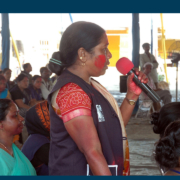Responding to Lassa Fever Through Risk Communication and Community Engagement Approaches: The Breakthrough ACTION-Nigeria experience
Lassa fever is an acute viral hemorrhagic illness caused by a virus. Humans usually become infected with Lassa virus through exposure to food or household items contaminated with urine or droppings of infected rats.1 In Nigeria, Bauchi State has experienced recurring Lassa fever outbreaks and other infectious diseases like cholera and yellow fever. Breakthrough ACTION-Nigeria conducted a human-centered design activity to generate ways to address this; during the discovery phase, the project found that outbreaks like Lassa fever are linked to poor personal hygiene practices, inadequate environmental sanitation, improper waste management, lack of clean water sources, inadequate safe food storage facilities, food handling, processing and insufficient education on signs and symptoms of the disease and overall poor health seeking behavior.

A Breakthrough ACTION-Nigeria FOMWAN trained community volunteer providing support to a community member to clean her environment. Credit: Valentine Edoziem
Since 2022, Breakthrough ACTION, funded by USAID, has supported Bauchi State’s efforts to combat Lassa fever by addressing behavior-related practices and enhancing case finding. The support focused on two key areas: risk communication and community engagement (RCCE) and environmental/vector control. Activities included strategic advocacy, capacity building, and targeted sensitization, such as compound meetings, community health dialogues, community dramas, motorized campaigns, and town hall meetings. Mass media efforts, including radio dramas, spots, media appearances, and live events, amplified the messaging, while environmental control measures like deratization further strengthened the impact. It also broadcast the radio drama Adventures of Wazobia in local languages across three stations, reaching approximately 2 million people.
To achieve this, the project leveraged existing community structures, including Local Government Area supervisors, community volunteers, and Ward Development Committees (WDCs), and established new partnerships with Civil Society Organizations (e.g., Nigeria Red Cross Society), Professional Associations (e.g., Environmental Health Officers Association of Nigeria), and Women’s Groups (e.g., Federation of Muslim Women Associations in Nigeria). The project also collaborated with Médecins Sans Frontières for sample collection and transport of laboratory-confirmed Lassa fever cases.
Between January and June 2024, Breakthrough ACTION contributed to active case search and community surveillance for Lassa fever. This contributed to the reporting of 154 suspected cases of Lassa fever with 25 confirmed across the 51 wards in four local government areas (LGAs): Bauchi, Kirfi, Tafawa Balewa, and Toro. The project and its partners worked to be sure the confirmed patients received appropriate and timely treatment and integrated back into the community.

Credit: Valentine Edoziem
The project conducted an after-action review to reflect on lessons learned from the Lassa fever response efforts.
- The activities implemented required engaging diverse community structures and building a pool of resource persons. By partnering with organizations such as Federation of Muslim Women Associations in Nigeria (FOMWAN), and the project expanded its human resources at the community and ward levels, each organization bringing its own audience and stakeholders. This collaboration allowed for broader coverage and scope, reaching new areas and audiences who would have otherwise been overlooked. For instance, environmental health volunteers, skilled in household and facility inspections, engaged markets, warehouses, and abattoirs on hygiene and sanitation. Additionally, these partnerships helped build the capacity of 171 volunteers, strengthening community ownership of RCCE activities. The volunteers, including Breakthrough ACTION-Nigeria community volunteers and WDCs, have become key change agents, continuing to improve the health and well-being of their communities.
- House-to-house activities offer an opportunity for deeper interaction and potential for behavior change than community wide activities. House-to-house visits provide an opportunity for direct interaction and interpersonal communication between the community members and the volunteers. Through these interactions, community volunteers can observe households’ practices such as food storage techniques and waste management practices with a view to proffering solutions that are home-specific thereby building trust. This level of engagement is not possible through community-wide activities.
- Applying local context to deratization technique encourages the potential for sustainable practices. The deratization exercise, in Toro LGA, led by Ministry of Environment, advised community members to use noodles and fish as bait in traps mixed with a rat-killing chemical. Noodles are a type of food made from unleavened dough which is either rolled flat and cut, stretched, or extruded, into long strips or strings2. However, the suggested ingredients are expensive for most community members to spend on bait; noodles cost as high as NGN 350 (USD 0.20) per 100 grams, the chemical costs at least NGN100 (USD 0.05), and fish at least NGN 300 (USD 0.18). Because of these prohibitive costs, community members modified this technique using locally available resources: water and a rodenticide called Komando, which is much less expensive.

Credit: Valentine Edoziem
References
- World Health Organization. (n.d.). Lassa fever. https://www.who.int/health-topics/lassa-fever#tab=tab_1
- https://en.wikipedia.org/wiki/Noodle
Written by: Valentine Edoziem, Olayinka Badmus, and Abdulmajid Ahmad



 Gopal Bhattacharjee/Photoshare
Gopal Bhattacharjee/Photoshare
 WHO
WHO Breakthrough ACTION
Breakthrough ACTION Photo credit: amy Rakotoniaina/PMI/Flickr
Photo credit: amy Rakotoniaina/PMI/Flickr